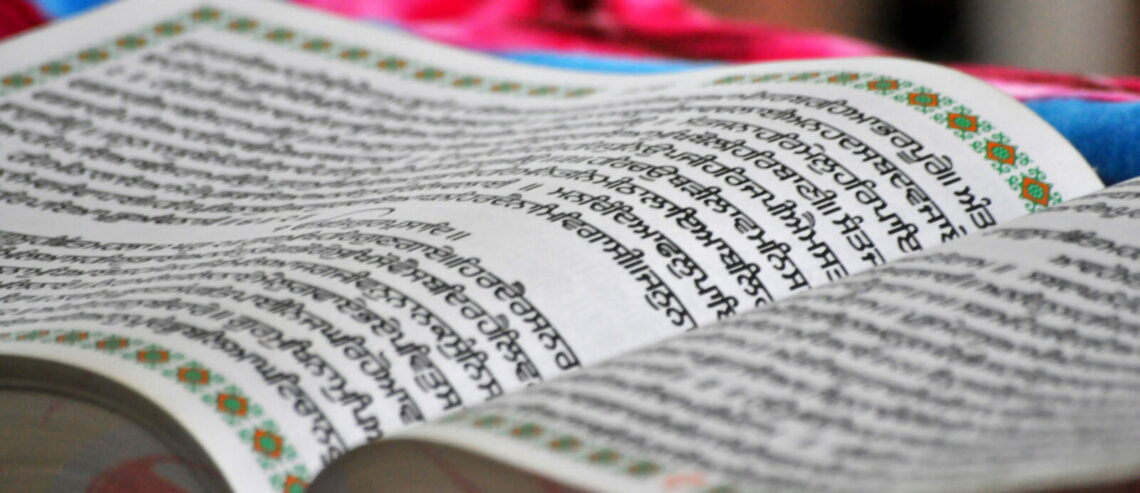At the Kaur Life Virtual Retreat in early August 2020, we had a Gurbani Vichar discussion lead by guest speakers Balpreet Kaur, Japman Kaur, and Ramandeep Kaur. Below are our notes from the session along with some worksheets. They sadly do not capture the richness of the small group conversations or the insights provided by the guest speakers. But, it will give you a glimpse into what was covered.
Session 3: Gurbani Vichar – Developing a Personal Connection with Guru Sahib
Guest Speakers: Balpreet Kaur, Japman Kaur, & Ramandeep “Rimmy” Kaur
Objective: The objective of this workshop is to assist participants in connecting with Guru Sahib on a personal level and creating enough familiarity, confidence, and love in connecting with Gurbaani that allows them to resist the patriarchy and misogyny present in many Sikh spaces. We want participants to leave understanding the necessity to ground our conversations in Gurbani, and also realize we can and must include Gurbaani and Guru Sahib’s voice in our analysis of Sikh history, rehat, Gurmat, and contemporary issues.
When you think of the word “God,” what do you think of?
- Ask yourself: What words or images come to mind when you hear the word “God”?
- Common words from retreaters: Waheguru, guy in the sky, divine, all knowing, love, creator, male, omnipotent, all encompassing, light, everything.
- Two camps:
- white guy separated, in the sky, looking down on us and judging us.
- Possibility of relationship and experience with this idea of God is narrow (along gender, ethnic, national, religious lines). So as Sikhs we must revisit Guru Nanak’s perspective on the world.
- But also there’s an abstract understanding of God dealing with feelings and experiences.
- white guy separated, in the sky, looking down on us and judging us.
The Paradigm of ੴ
- To understand the Divine, we as Sikhs must always go back to the Mool Mantar and Ik Onkar.
- ੴ ਸਤਿ ਨਾਮੁ ਕਰਤਾ ਪੁਰਖੁ ਨਿਰਭਉ ਨਿਰਵੈਰੁ ਅਕਾਲ ਮੂਰਤਿ ਅਜੂਨੀ ਸੈਭੰ ਗੁਰ ਪ੍ਰਸਾਦਿ ॥
- ikOankaar sat naam karataa purakh nirabhau niravair akaal moorat ajoonee saibha(n) gur prasaadh
- Ik Onkar:
- Usually translated as “God is One”. But when we break down the word, we get a different picture.
- Affirmation of Guru Nanak’s experience of the Divine and reality, which is One – universal, eternal, and beyond understanding.
- Ik Onkaar is universal, no barriers; barriers exist because of ourselves not because of the Divine.
- Connect to a genderless, timeless, placeless, eternal, and everlasting, and universal Divine force.
- Accessed through Guru’s Grace – implies a relationship.
- Ik Onkar is an affirmation of the reality that we exist in.
- Mool Mantar is a description of the Divine based on characteristics we can relate to – it is truth, creative, without fear, without hate, etc.
- Ask yourself: How are you applying this to your life?
- Ik Onkar:
Guru
- What is Guru?
- Gu | Ru —> Darkness | Light
- Two words: Gu (darkness) and Ru (Light).
- literal translation: someone who takes you from darkness to light.
- Some folks don’t like using darkness to light analogy because of its connotation of a color value judgment
- Applicable/abstract translation: someone who takes you from ignorance to knowledge/enlightenment.
- Someone who gives guidance, our GPS, our advisor, a teacher.
- As time passes, the relationship becomes more intimate like best friend or companion in life. The descriptions evolve over time.
- Gurbani defines Guru as perfect:
- The thing that separates the Guru from the rest of the world – Guru is perfect.
- Everyone has capacity to make mistakes, but Guru is perfection.
- Guru Nanak Aahib, Ang 60: ਭੁਲਣ ਅੰਦਰਿ ਸਭੁ ਕੋ ਅਭੁਲੁ ਗੁਰੂ ਕਰਤਾਰੁ ॥ bhulan a(n)dhar sabh ko abhul guroo karataar || Everyone makes mistakes; only the Guru and the Creator are infallible. Todos están expuestos a ser engañados excepto el que dirige su mente hacia Dios.
- When you want to learn math, go to a math teacher. When you want to learn science go to a science teacher. When you want to learn about life, get happiness- go to the Guru.
What is Gurbani?
- Teacher and the insights.
- A person’s relationship with Guru Granth Sahib changes over time as they connect more (and in different ways) with Guru Sahib.
- We see ourselves in Bani and Bani reflects itself in us.
- Gurbani is meant to be experienced. It is an experience that goes beyond our words and beyond our understanding.
- Our words for Bani are experienced first hand. There’s an intellectual aspect, but the experience goes beyond our words and intellect that facilitates a deeper relationship with Guru.
- Guru Granth Sahib
- ਗੁਰੂ Guru ਗ੍ਰੰਥ Granth ਸਾਿਹਬ Sahib
- The name of this Guru indicates our relationship with the Guru:
- Granth = important texts.
- Guru as a text
- Sahib = master, sovereign, someone who set precedent and hold power and dominion over others. Someone who demands political and social allegiance.
- Ask yourself: Am I loyal to this Sahib? Can I pledge allegiance to this sovereign? What would that take? How does my relationship change when I give my head to the sovereign literally when I matha tek?
- Granth = important texts.
- Level of complexity in languages, poetry, and intellectually is incredible.
- Can look at Guru Granth Sahib using many different lenses, like psychology or international development, and can learn something new.
Describe your relationship with Bani in three words:
- Ask yourself: What are three words to describe your relationship with Gurbani?
- Common words from participants: love, comforting, intimidating, peace, complicated, trust, aspirational, inspirational, helpful, learning…
Embracing & redefining the human experience
- What differentiates Gurbani from anything else: how it embraces and personifies the human experience using language, poetry, music, relationships, and timelessness <— Gurbani is accessible in this way.
- Language:
- Guru Sahib uses language so that everyone has access to the Divine (especially at a time when Sanskrit was a reserved language of spirituality for the privileged).
- 8 different language families that can relate widely such as Lahnda (Western Punjabi), Braj Bhasha, Kauravi, Sanskrit, Sindhi, and Persian.
- Guru Sahib uses language so that everyone has access to the Divine (especially at a time when Sanskrit was a reserved language of spirituality for the privileged).
- Music:
- Raags (melodic framework similar to a Western key singature) as an expression.
- Poetic genres:
- Poetic genres were prevalent in communities and understood widely, like Barah Maha, Ashtpadees, Vaars, etc.
- Used contemporary art styles to democratize access to spiritual understanding and access to Guru.
- Relationships:
- Gurbani refers to human relationships: partners, siblings, parents, social groups, experts, master/slaves, orphans, etc.
- Human relationships are used in Bani to anchor us and help draw parallels between the human experience, rather than validating the human relationships themselves. Guru uses human relationships to connect to a truer reality with the Divine.
- Man raam naam:
- This is the human experience, but also none of this is real, your real relationship is with Akaal Purakh.
- We sing typical shabads during big moments like birthdays (poota maata kee asees)
- Guru is not just celebrating that human relationship, but actually reminding Sikhs to not be attached to these worldly relationships, and to focus instead on our relationship to the Divine.
Guru Granth & Guru Panth
- Keeping this rehat is an expression of our love for Guru Sahib’s path given to us.
- Guru Panth Identity is also literal – importance of accepting Khande baatey ki Pahul (Amrit) in our lives.
- We sometimes seek validation for our Rehat in all different places – we see body hair on Instagram stories and use to validate our own identity.
- Our experience is truly unique, only belonging to the Guru, not to anything else.
- Responsibilities of a Sikh is both for the individual and for collective panth and for humanity
- Bani is a lived experience – all about centering our identity with the Guru
- BIPOC women vs Sikh experiences
Guru Granth and Guru Panth:
- Application of Guru Granth rises to actions within the Guru Panth.
- Gurbani unites us all. When we act on that Bani, and live that Bani, we become part of the Guru Panth.
- Ask yourself: How are you applying Gurbani in your daily life?
My Guru & Me – Reflection questions:
- Is there someone you currently want to mend a relationship with? How does it feel? Not a relationship that harmed you, just one you’d like to reconnect with.
- Have you successfully mended a relationship before? What did it take from you to repair that relationship?
The Experience – A Shabad
Below is the shabad you will be discussing in your small groups, Raag Aasaa – Sri Guru Granth Sahib Ji – Ang 389 – Revealed to Guru Arjan Sahib. Read it and using Worksheet 1, try to develop your own interpretation of it. After your interpretation exercise, you can look over Worksheet 2 to see how Sikhi to the Max interpreted the shabad. Lastly, discuss the reflection questions on Worksheet 3 in your small groups.
You can har the shabad here sung beautifully by Simrit Kaur:
ਰਾਗੁ ਆਸਾ – ਸ੍ਰੀ ਗੁਰੂ ਗ੍ਰੰਥ ਸਾਹਿਬ ਜੀ – ਅੰਗ 389
Raag Aasaa – Sri Guru Granth Sahib Ji – Ang 389
ਆਸਾ ਮਹਲਾ ੫ ॥
aasaa mahalaa panjavaa ||
ਸੋਇ ਰਹੀ ਪ੍ਰਭ ਖਬਰਿ ਨ ਜਾਨੀ ॥
soi rahee prabh khabar na jaanee ||
ਭੋਰੁ ਭਇਆ ਬਹੁਰਿ ਪਛੁਤਾਨੀ ॥੧॥
bhor bhiaa bahur pachhutaanee ||1||
ਪ੍ਰਿਅ ਪ੍ਰੇਮ ਸਹਜਿ ਮਨਿ ਅਨਦੁ ਧਰਉ ਰੀ ॥
pria prem sahaj man anadh dharau ree ||
ਪ੍ਰਭ ਮਿਲਬੇ ਕੀ ਲਾਲਸਾ ਤਾ ਤੇ ਆਲਸੁ ਕਹਾ ਕਰਉ ਰੀ ॥੧॥ ਰਹਾਉ ॥
prabh milabe kee laalasaa taa te aalas kahaa karau ree ||1|| rahaau ||
ਕਰ ਮਹਿ ਅੰਮ੍ਰਿਤੁ ਆਣਿ ਨਿਸਾਰਿਓ ॥
kar meh a(n)mrit aan nisaario ||
ਖਿਸਰਿ ਗਇਓ ਭੂਮ ਪਰਿ ਡਾਰਿਓ ॥੨॥
khisar gio bhoom par ddaario ||2||
ਸਾਦਿ ਮੋਹਿ ਲਾਦੀ ਅਹੰਕਾਰੇ ॥
saadh moh laadhee aha(n)kaare ||
ਦੋਸੁ ਨਾਹੀ ਪ੍ਰਭ ਕਰਣੈਹਾਰੇ ॥੩॥
dhos naahee prabh karanaihaare ||3||
ਸਾਧਸੰਗਿ ਮਿਟੇ ਭਰਮ ਅੰਧਾਰੇ ॥
saadhasa(n)g miTe bharam a(n)dhaare ||
ਨਾਨਕ ਮੇਲੀ ਸਿਰਜਣਹਾਰੇ ॥੪॥੨੫॥੭੬॥
naanak melee sirajanahaare ||4||25||76||
Session 3 Guest Speakers
Balpreet Kaur

Balpreet Kaur (she/her) is an educator, activist, and organizational psychologist with a passion for social impact, research and all things that prompt a deeper reflection on the complexities of life. She’s a firm believer that the world is held up by compassion and courage. Because of this, Balpreet has worked and volunteered extensively with nonprofit organizations across various sectors, including health care, humanitarian aid, and housing to create strategies that increase organizations’ capacity to be better, think better, and, ultimately, do better.
A lifelong learner, she graduated with a master’s of science in applied psychology from the University of Southern California as well as two bachelor’s degrees in international development and neuroscience from the Ohio State University. You may find her teaching, translating texts, learning languages, knitting, baking, watching psychological thrillers, or reading any and every book that strikes her brain cells.
Twitter: @balihaaree | Instagram: @balihaaree
Japman Kaur

Japman Kaur (she/her) has a passion for leading community work and projects, especially involving youth with organizations like Sikh Youth Alliance of North America (SYANA). She co-produced the documentary, “Pingalwara: In Letter & Spirit”. She has been actively attending and organizing Sikh Gurmat camps and retreats for the majority of her life and hopes to continue staying involved in Panthic projects. Japman Kaur is a Program Coordinator at McGill University. She loves to bake, try new recipes and genuinely appreciates a good nap.
Twitter: @chakvee | Instagram: @chakvee
Ramandeep “Rimmy” Kaur

Ramandeep (she/her) is an extroverted introvert who loves panjabi cooking, keertan and community building. She loves meeting new people, diving deep into learning new things, and bringing people together. In the daytime she puts these skills to use as the global product trainer at a tech startup in the bay; on nights and weekends she’s out making new best friends with strangers she meets in other countries at a local pizza spot.
Instagram: @rimmykayy
Photo of Guru Granth Ssahib by Jasleen Kaur





No Comments